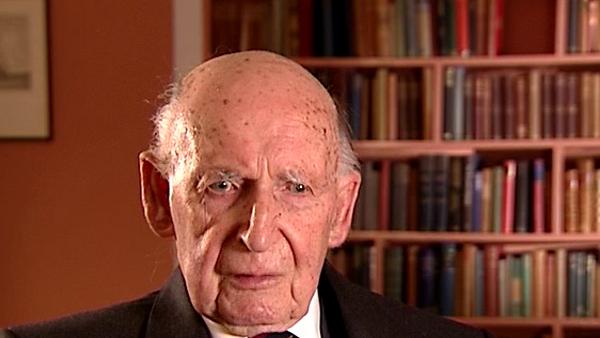NEXT STORY

Being given the job of improving the bombing success rate
RELATED STORIES

NEXT STORY

Being given the job of improving the bombing success rate
RELATED STORIES


|
Views | Duration | |
|---|---|---|---|
| 21. Orders to move to Bomber Command: A lucky escape | 189 | 02:07 | |
| 22. Writing a paper on radar echoes from cosmic ray showers | 208 | 03:04 | |
| 23. Working with the Admiralty | 138 | 02:52 | |
| 24. Being given the job of improving the bombing success rate | 149 | 07:52 | |
| 25. Getting the radar system into a Halifax bomber | 171 | 03:23 | |
| 26. Testing the radar system in the Halifax and a threat from the... | 153 | 04:28 | |
| 27. Continued testing with the Halifax and tragedy strikes | 1 | 168 | 04:38 |
| 28. A meeting with Winston Churchill and Robert Renwick | 303 | 04:44 | |
| 29. Don Bennett and the RAF Pathfinder Force | 261 | 01:26 | |
| 30. Continued work on H2S | 164 | 01:21 |


We... I had... my equipment... officer had our own equipment then which were being built in the aircraft, but I had quite a large ground equipment. On which I was constantly putting improvements and on this field at Leeson House, looking across the bay at Swanage, I could easily see ships and so on, and one day we arranged for a submarine, HMS Usk, to come into the bay and lo and behold, there was a clear echo from the submarine on our screen. And we summoned the people from the Admiralty Signal School and, you know, this was an amazing diversion of our efforts.
After some doubts, we demonstrated that we could detect this submarine at a range of eight or ten miles, and we... I drove the equipment down to... I think it was Peveril Point over Swanage Bay, and there demonstrated this and they said, 'Oh well, of course, if we ever put this on a destroyer, the roll and the rock' and I said, 'That's no problem, instead of using a paraboloid, we'll use a cylindrical paraboloid, which has... although it has a narrow beam and azimuth has a very, very broad beam and elevation, so if your ship rolls, you won't lose the echo'. And it was just before Christmas of 1940 that they took my equipment away to the Signal School in Portsmouth and I thought: oh dear, it's going to be a long time before I see any result of that. I was completely mistaken. In a remarkably short time, within months, they had this equipment working at sea, on a Corvette and that's the story of how centimetres got into the Admiralty.
The other diversion we had was in using the centimetre technique to direct the anti-aircraft guns. This we put another person... another person was put in charge of that. I had nothing to do with it but it was not terribly successful it was eventually... a brilliant system was eventually made and used later in the war by the Americans and we will come to the American story in due course.
Bernard Lovell (1913-2012), British radio astronomer and founder of the Jodrell Bank Observatory, received an OBE in 1946 for his work on radar, and was knighted in 1961 for his contribution to the development of radio astronomy. He obtained a PhD in 1936 at the University of Bristol. His steerable radio telescope, which tracked Sputnik across the sky, is now named the Lovell telescope.
Title: Working with the Admiralty
Listeners: Megan Argo Alastair Gunn
Megan Argo is an astronomer at the University of Manchester's Jodrell Bank Observatory researching supernovae and star formation in nearby starburst galaxies. As well as research, she is involved with events in the Observatory's Visitor Centre explaining both astronomy and the history of the Observatory to the public.
Alastair Gunn is an astrophysicist at Jodrell Bank Observatory, University of Manchester. He is responsible for the coordination and execution of international radio astronomical observations at the institute and his professional research concerns the extended atmospheres of highly active binary stars. Alastair has a deep interest and knowledge of the history of radio astronomy in general and of Jodrell Bank in particular. He has written extensively about Jodrell Bank's history.
Tags: Leeson House, Swanage, HMS Usk, Admiralty Signal School, Peveril Point, Swanage Bay, Portsmouth, Christmas
Duration: 2 minutes, 52 seconds
Date story recorded: January 2007
Date story went live: 05 September 2008